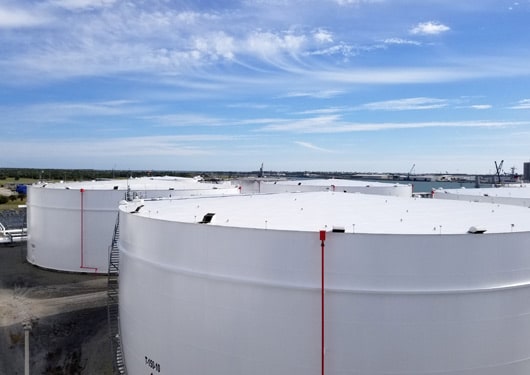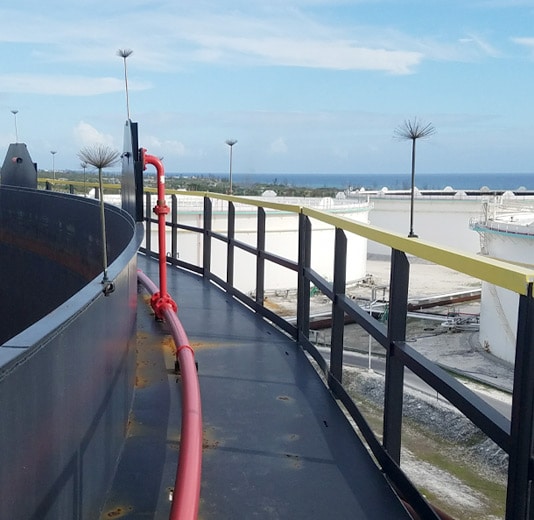STREAMER FORMATION
What is the difference between Fuzzy Ball and regular old and Franklin lightning rods? Well, not much and a whole lot.
Physically, the only difference is the addition of a multiplicity of small radius electrodes (wires) inserted into the tip of the elevation conductor of the air terminal. Everything else in the system is identical, including the grounding system, main and down conductors, clips, clamps, bases, etc. In addition, all components are Underwriters Laboratories UL 96 listed, and the completed system is eligible for a UL Master Label, Letter of Findings, or Engineering Inspection Report, as appropriate. In fact, virtually any Franklin lightning rod system may be converted to a Lightning Master SRAT system by simply unscrewing the lightning rods and screwing in Lightning Master streamer-retarding air terminals.
If the differences are so small, then why the Lightning Master approach? The small wire electrodes greatly enhance dissipation of ground charge to the atmosphere by virtue of their small radius (sharpness). Lightning attachment is determined by streamer formation. Whichever object on the surface of the earth emits the best streamer, wins. Corona is the controlled, lower energy dissipation of ground charge sometimes called St. Elmo’s fire. These small radius points break down into corona under a much lower potential (voltage) than a rounded or even pointed Franklin lightning rod, reducing total charge accumulation, and making it more difficult for a sufficient amount of ground charge to accumulate to form a streamer. As the air terminal breaks down into corona sooner, it dissipates the charge over a longer period of time.
Imagine the corner of a structure. The charge on the base of the storm cloud pulls the ground charge surrounding the structure up and onto the corner of the structure. As the storm builds in intensity, the difference in potential between the cloud base charge and the corner of the structure builds. When the difference in potential overcomes the dielectric (resistance) of the intervening air, the difference in potential is equalized by a lightning strike. In order for the corner of the structure to emit a streamer, the ground charge must accumulate sufficiently to do so. The ground charge leaking off the small radius points interferes with that accumulation.
In its primary mode, the SRAT dissipates the ground charge that would otherwise form a lightning-completing streamer, reducing the likelihood of direct lightning attachment. If the ground charge rises too quickly or builds too high, the dissipation ability of the air terminal may be exceeded. In that event, the air terminal reverts to its secondary mode of a Franklin lightning rod. Since the SRAT is located at the top of the structure as required by both NFPA 780 and UL 96A, and it is already saturated with streamer constituting ground charge, the SRAT then emits a streamer, reliably collecting any strike and conveying it to ground over the lightning protection system.
GENESIS OF THE TECHNOLOGY
Lightning Master’s original exposure to structural lightning protection for buildings was at the Veterans Administration Hospital in Bay Pines, Florida. The building had suffered a direct lightning strike to the roof between lightning rods. The strike punctured the roof, melting the roofing material. Building maintenance had heard about Lightning Master and asked us to see if we could develop a solution to their problem. At that time, Lightning Master provided lightning protection mostly for broadcast and communications facilities. In response, we developed an air terminal employing streamer-retarding technology that slipped over and crimped on to a Franklin lightning rod. In order to obtain a UL Listing, we later modified the product, so it no longer slipped over, but replaced a Franklin lightning rod.
EXPLANATORY MODELS AND EXAMPLES
To explain this phenomenon, we sometimes use one or more of the following examples or models. Sometimes it helps to envision taking the protected structure, turning it upside down and dipping it in syrup. When the inverted structure is lifted from the syrup, the syrup tends to drip off the outside edges, corners, and any protrusions. These points are analogous to the charge accumulation and streamer formation points of that structure, and can help make it clear why those points are most likely to be struck by lightning. It also explains why NFPA 780 and UL 96A locate lightning rods at those locations. The SRAT’s dissipate ground charge off, and delay streamer formation from, the locations most likely to be struck by lightning.
When talking with engineers, it is sometimes helpful to use a variation of Coulomb’s law showing that the smaller the radius of a point, the greater the electric field intensity surrounding it. This explains the greater dissipation current from a SRAT than from a Franklin lightning rod.
At trade shows, we sometimes use a Van de Graaff generator to show the difference in dissipation between objects of various shapes. Where the point of a car key or Franklin lightning rod may arc 1/2” to 1” or so to a 200,000-volt Van de Graaff, a Lightning Master SRAT may be touched to the generator ball without arcing. We also use the Van de Graaff to show the ability of an electrical field to induce current in a piece of metal. That piece of metal then arcs to any other piece of metal brought into proximity to it, demonstrating a common cause of ignition, particularly at oilfield facilities.




